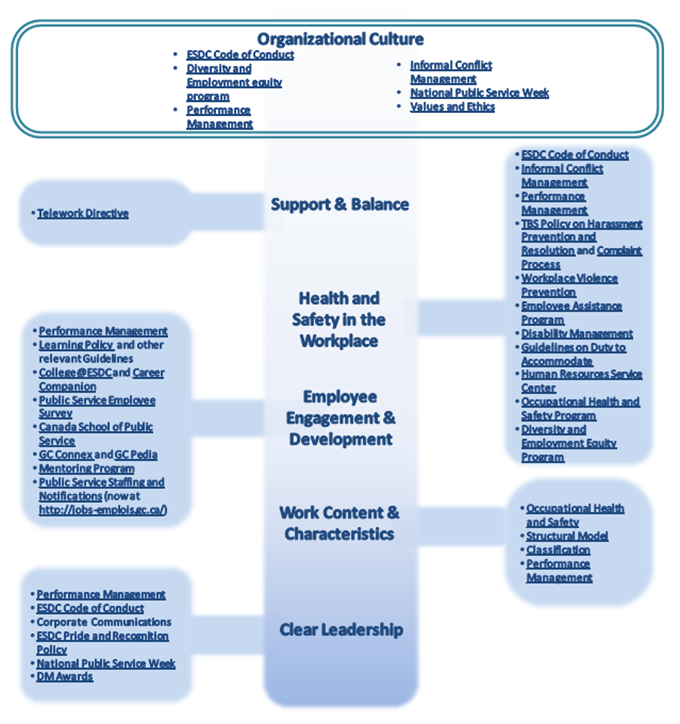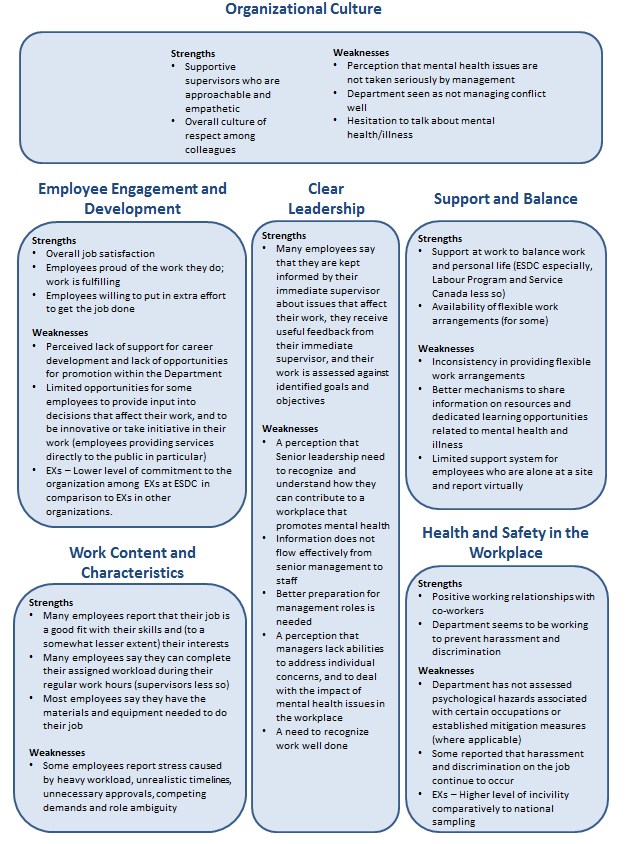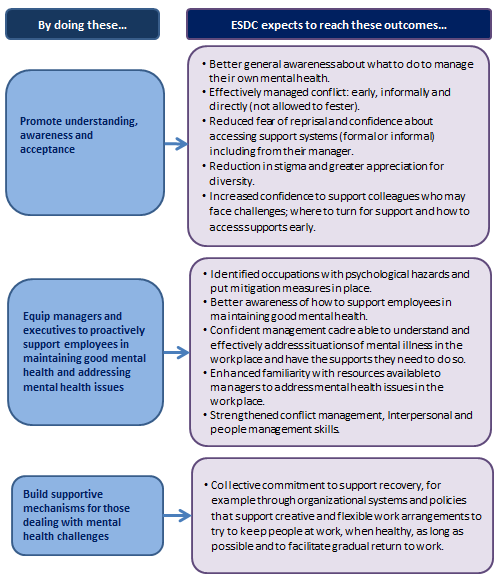An Integrated Framework: A Shared Path Towards Mental Health in the Workplace 2015-2018
Table of contents
- Introduction
- Why is mental health important in the workplace?
- What have we done to mobilize and inform ourselves?
- What did we hear and learn about ESDC's workplace?
- How can we approach mental health in the workplace?
- What we want to create? vision, outcomes and guiding principles?
- Action plan
- Monitoring
- Conclusion
- Annex A – references and resources

Full version
(print-friendly version)
Introduction
An organization's most valuable resource is its employees. Without them, an organization cannot succeed, be productive or meet its mandate. This is why it is so important to support our employees so they can be contributing, healthy and well balanced members of the organization.
The World Health Organization (WHO) defines health as "…a state of complete Physical, Mental and Social Well-being and not merely the absence of disease or infirmity."1 This holistic view implies that these components are linked together, in a way that makes them interdependent.
The WHO also recognizes that "mental health is a state of well-being in which the individual:
- realizes his or her own abilities;
- can cope with the normal stresses of life;
- can work productively and fruitfully; and
- is able to make a contribution to his or her community’.
We are however increasingly aware that many people suffer from mental health issues at different times in their lives. According to the Mental Health Commission of Canada (MHCC), one in five Canadians experiences a mental health problem or illness in any given year2. Among those, two out of every three adults who need mental health services/treatment do not receive it because of the stigma associated with mental illness (MHCC, 2009).
As individuals, we are responsible for our own well-being. Organizations can also play an essential role. While it is often easier to recognize a physical injury/illness in someone, psychological health and safety should be treated with equal importance. The manager’s role is to ensure a healthy and safe workplace to help employees perform well. They are not expected to make a diagnosis or take care of a person’s illness; only specialists can do this.
In support of employees and those with supervisory functions, this Integrated Framework encompasses a three-year action plan that ESDC can take to respond to what we have learned and heard about mental health in the workplace.
Why is mental health important in the workplace?
Building a mentally healthy workplace has many benefits. It is not only to meet the managers’ legal obligations3 to protect employees’ health and safety; it is also the smart thing to do and the right thing to do. Research demonstrates that it contributes to employee morale, reduces absenteeism, and improves productivity and employee retention.
Employment and Social Development Canada (ESDC) has taken positive steps to create a healthy and safe workplace. These include the introduction of:
- A robust Occupational Health and Safety Program
- Informal Conflict Management Services
- Employee Assistance Services (EAS) for employees and their families
- A Disability-Absence Management Initiative
- Duty to Accommodate Guidelines
- The ESDC Code of Conduct
- Advisory services for managers through EAS
However, when it comes to addressing the issue of mental health in the workplace, more could be done. Mental health can be complex, difficult and uncomfortable for some to deal with. There is no one magic solution; but we do know that sound workplace management practices are one of the best ways to prevent problems and increase workplace well-being.
"A healthy workplace is one in which workers and managers collaborate to use a continual improvement process to protect and promote the health, safety and well-being of all workers and the sustainability of the workplace..."
- Healthy Workplaces: A Model for Action, World Health Organization
What have we done to mobilize and inform ourselves?
A steering committee was established in June 2014 with a mandate to develop an integrated framework and concrete actions to guide our efforts and priorities in enhancing the psychological health and safety of our employees. The committee was comprised of employees from various occupational groups and levels, from different business lines, and from the National Headquarters and the Regions.
The committee looked at what ESDC is already doing in support of workplace psychological health and safety (see Diagram 1); what other organizations are doing, and what employees are saying about their work environment. As part of this exercise, discussions took place with employees, managers, and bargaining agents to understand their experiences with mental health at work and to identify suggestions for moving forward. The committee also explored related studies (e.g. 2011 Public Service Employee Survey, 2012 Association of Professional Executives of the Public Service of Canada (APEX) Work and Health Survey) to help guide discussions.
Diagram 1: Indicative ESDC services/program4 that support workplace factors that influence psychological health and safety

Full graphic version: diagram 1
Text version: diagram 1 (DOCX, 20 KB)
What did we hear and learn about ESDC’S workplace?
Through research, consultations and feedback, several areas of strength were brought forward: high overall levels of engagement and positive working relationships were identified within ESDC; many employees say that they like their job, they are proud of the work they do and that their job is a good fit with their skills and interests; many also report having good working relationships with their co-workers and a good rapport with their immediate supervisor.
We also heard that there are areas requiring attention. Some issues that were most often mentioned include: getting meaningful recognition for work well done; being more involved in decisions that affect their work (workload, unrealistic timelines and role ambiguity); more opportunities to learn about mental health and what resources are available; reassurance that senior management understands what mental health issues are and how they can contribute to a workplace that promotes mental health; some levels of harassment and discrimination are present in the workplace. Employees also expressed concerns about managers’ capacity (skills) to handle the various aspects of managing people that go with the job.
Based on these views and perceptions, what we heard as the most critical and persistent gaps were:
A need for awareness
- Increasing personal understanding of the issue to remove the stigma make it possible to discuss it.
A need for training
- Tailored training for executives, managers and human resources professionals on how to support and respond to mental health issues that are present in the workplace;
A need for tools:
- to improve communication between senior management and staff;
- to influence prompt and effective responses to mental health issues; and
- to provide quicker manager access to expert resources and more tools.
In addition, employees who assume managerial roles require support to learn and implement sound people management practices.
See Diagram 2 for additional details
Diagram 2: Indicative ESDC strengths and weaknesses relative to workplace factors that influence psychological health and safety

- Sources accessed: 2011 Public Service Employee survey, 2012 Association of Professional Executives of the Public Service of Canada (APEX) work and health survey.
- Note: In the matter of Mental Health, perceptions are often as important as facts, especially if generalized or recurrent.
Full graphic version: diagram 2
Text version: diagram 2 (DOCX, 19 KB)
How can we approach mental health in the workplace?
It becomes evident that many workplace factors can influence mental health.5 We have identified five categories of workplace psychosocial factors that contribute to a healthy and safe workplace and may moderate negative effects of workplace demands on employees and organizational outcomes. These are:
- employee engagement and development;
- health and safety in the workplace;
- work content and characteristics (job fit, workload management);
- clear leadership direction; and
- support and balance.
The overall context of ESDC organizational culture contributes to these five factors. Organizational culture is pervasive and powerful; it is about lived experiences in the workplace; the explicit and implicit processes, beliefs, attitudes and assumptions of people. There is a shared responsibility for creating an organizational culture that supports mental health in the workplace.
What do we want to create? vision, outcomes and guiding principles
The vision for ESDC is to be a workplace that promotes psychological health and safety and encourages employees and managers to address mental health concerns openly.
Over the next three years, ESDC will progressively work towards our vision while ensuring a balance between promotion of health, prevention of harm and resolution of incidents/concerns which all support a psychologically healthy and safe workplace:6. ESDC will:
Promote understanding, awareness and acceptance
- Employees have the information to recognize signs of their own stress levels and how to seek help.
- Increase confidence to openly discuss mental health at work.
Equip managers and executives to proactively support employees in maintaining good mental health and addressing mental health issues.
- Protect the health and safety of employees to prevent injury/illness at work.
Build supportive mechanisms for those dealing with mental health challenges
- Proactively access stay-at-work initiatives, support for recovery and return-to-work planning
Our workplace environment needs to foster healthy, safe, positive and productive work experiences for all employees. The outcomes (see Diagram 3) set out for ESDC under this Framework will enhance that experience.
The following principles will guide us in our day-to-day interactions as we work towards our vision and outcomes.
Respect
Respectful workplace relationships at all levels, including senior managers, managers, employees and employee representatives.
Shared responsibility
Active participation of all workplace stakeholders:
- Each individual is responsible for their own health; and
- Employees and managers are mutually responsible to communicate any issues that may impact their work, well-being and/or the health of the workplace.
Senior management engagement
Visible commitment to:
- develop and sustain a psychologically healthy and safe workplace;
- include considerations related to psychological health and safety in organizational decision-making processes; and
- identify and conform to the legal requirements applicable to ESDC to provide a healthy and safe workplace.
Diagram 3: activities linked to outcomes

Full graphic version: diagram 3
Text version: diagram 3 (DOCX, 16 KB)
Action plan
The Framework offers a series of concrete actions that leverages existing ESDC programs, services and tools; aligns with ESDC and Government of Canada’s initiatives (Performance Management, Blueprint 2020) and links to best practices from the federal public service, industry, and ESDC’s branches and regions.
The identified actions set out below places emphasis on the promotion of health and the prevention of harm, while reinforcing our capacity to support resolution of incidents/concerns.
Promotion of health
| Targeteda audience | Current programs and services | Actions | Year 1 | Year 2 | Year 3 |
|---|---|---|---|---|---|
| Executives | #1 Organize discussion/learning sessions with senior management (i.e. PMB) to inform/educate on mental health and get a strong or visible commitment.
Effort = high |
✓ | |||
| Executives | #2 Identify and promote executive learning options at three levels:
APEX Breaking the Silence Training could be used as a resource. Effort = medium |
✓ | |||
| Employees and managers | Health Canada’s Employee Assistance College@ESDC |
#3 Develop a menu of learning options appropriate to meet ESDC needs to enhance understanding of mental health.
Effort = medium |
✓ | ||
#4 Connect with the Canada School of Public Service to explore how mental health may be integrated into their existing suite of learning products. Effort = low |
✓ | ||||
#5 Establish procedures/protocols to facilitate access to mental health learning opportunities Effort = low |
✓ | ||||
| Employees | Informal Conflict Management Services Values and Ethics |
#6 Develop new learning tool to facilitate discussions and resolve workplace conflict when mental health issues could be part of the situation. Effort = high |
✓ | ||
#7 Increase proactive promotion of coaching services. Effort = low |
✓ | ||||
| Employees and managers |
|
#8 Develop a dedicated iService site on mental health where self-serve information is accessible to all employees to reinforce learning, understanding of issues and help manage personal/workplace challenges. Effort = high |
✓ | ||
| Employees | Health Canada’s Employee Assistance Services |
Develop and make accessible a suite of practical learning tools and resources that build personal resilience, and hones in on skills such as healthy thinking patterns, stress-reduction techniques and self-care, in particular but not limited to: |
|||
#9 Offer ‘Developing Personal Resilience Resources’ sessions for all employees (through Health Canada) across regions Effort = low |
✓ | ||||
#10 Implement and promote a ‘mental health passport’ tool for employees to use as a check-in on their own mental health (based on a Statistics Canada’s model). Effort = medium |
✓ | ||||
| Employees | Health Canada’s Employee Assistance Services |
#11 Increase promotion of Employee Assistance Services:
Effort = low |
✓ | ✓ | ✓ |
| Employees | Corporate Communications |
#12 Increase communications on the issue of mental health and access various communication vehicles. For example:
Effort = medium (high for videos) |
✓ | ✓ | ✓ |
Prevention of harm
| Targeted audience | Current programs and services | Actions | Year 1 | Year 2 | Year 3 |
|---|---|---|---|---|---|
| Human Resources | DTA Guidelines DTA online training, Proactive absence management & return to work, which includes: Process guide and on-line training |
#13 Enhance how HR existing programs and services can support mental health in the workplace. Effort = low |
✓ | ||
#14 Enhance integrated approach to providing human resources advisory services to managers (LR, DTA, etc.) Effort = low |
✓ | ||||
| Managers | Occupational Health and Safety Program, including a Hazard Prevention Program |
#15 Identify psychological hazards for certain occupations where employees are at higher risk of exposure to critical incidents and/or cumulative stress and ensure management action plans developed to mitigate risk: |
|||
|
✓ | ||||
|
✓ | ||||
Effort = high |
✓ | ||||
| Managers | Occupational Health and Safety Program |
Implement a standardized process to identify hazards impacting physical health and safety and take measures to address in a timely manner. |
|||
#16 Implement workplace inspection guidelines and check list. Effort = low |
✓ | ||||
| Employees | ESDC Code of Conduct Office of Values and Ethics TBS Policy on Harassment Prevention and Complaint Process Informal Conflict Management Services |
#17 Reinforce a zero tolerance for harassment in the workplace: Promote the prevention of harassment, discrimination, bullying through Values and Ethics training and awareness. Effort = low |
✓ | ||
| Managers | Health Canada’s Employee Assistance Services ESDC Workforce Plan |
#18 Reinforce People Management and Leadership skills:
Effort = medium |
✓ | ||
Resolution of incidents/concerns
| Targeted audience | Current programs and services | Actions | Year 1 | Year 2 | Year 3 |
|---|---|---|---|---|---|
| Employees | Build informal networks to support employees dealing with possible challenges and other employees to be supportive |
||||
#19 Support to team-based conversations – provide a process and hands-on guides for teams (and their managers) to learn and develop together: Having the conversation with my team. Effort = high |
✓ | ||||
#20 Develop a peer support program to help employees respond in a supportive manner to co-workers who may be struggling. |
✓ | ||||
Effort = high |
✓ | ||||
| Human Resources | Build capacity for HR practitioners in supporting managers dealing with mental health challenges in the workplace. |
||||
#21 Mental health first aid for all Labour Relations practitioners Effort = low |
✓ | ||||
#22 Create action learning opportunities for HR practitioners to share experiences, best practices and discuss challenges. Effort = high |
✓ | ||||
| Managers | Build capacity for managers to discuss challenges around mental health issues and learning from colleagues’ experience. |
||||
#23 Create action learning opportunities to share experiences, and discuss challenges and solutions. Effort = high |
✓ | ||||
#24 Organize specialized sessions through Health Canada to address trends/challenges. Effort = medium |
✓ | ||||
| Managers | ESDC Code of Conduct Office of Values and Ethics TBS Policy on Harassment Prevention and Complaint Process Informal Conflict Management Services |
#25 Reinforce a zero tolerance for harassment in the workplace: Revisit ESDC procedures/process to respond to issues of harassment (formal and informal) and improve ability to resolve issue of harassment more effectively. Effort = medium |
✓ | ||
Dependencies
- Branch and regional engagement at both the leadership and branch/regional representative levels.
- Engagement and alignment with related programs, projects, services and tools.
- Many actions identified above are dependent on the collaborative effort of various HR disciplines.
Monitoring
The framework is an evergreen document that will be monitored through regular data collection and with the participation of managers, employees, Human Resources and external partners (e.g. Health Canada).
Progress will be reported to senior managers (at critical stages in the implementation) to ensure ongoing actions and initiatives are meeting the needs of employees and the organization.
A full review will be achieved at the end of the three year plan.
Conclusion
At some point, anyone may need to deal with mental health issues. Through commitment and understanding, each of us, ESDC’s employees, managers and executives are on a path to improving the psychological health and safety in our workplaces.
This means creating a workplace culture more knowledgeable about mental health, more understanding of mental health issues, and better equipped to support our employees or colleagues when a mental health issue or illness is at play.
Note: EDSC would like to acknowledge the contribution made by NxKnowledge Corporation in the development of this Integrated Framework.
Annex A - reference and resources
Reference
- CSA Group and Bureau de normalisation du Québec. (2013). Psychological Health and Safety in the Workplace – Prevention, promotion, and guidance to staged implementation. CAN/CSA-Z1003-13/BNQ 9700-803/2013. Mississauga, Ontario.
http://shop.csa.ca/en/canada/occupational-health-and-safety-management/cancsa-z1003-13bnq-9700-8032013/invt/z10032013 - Shain, Martin, Tracking the Perfect Legal Storm (PDF, 3.62 MB)
- Preamble to the Constitution of the World Health Organization as adopted by the International Health Conference, New York, 1948.
- Mental Health Commission of Canada, Making the Case for Investing in Mental Health in Canada, March 2013. (PDF, 1.72 MB)
Resources
General information
Resources for managers
- A Manager’s Guide for Mental Health First Aid in the Workplace
- Mental Health Works - Nationally available program of the Canadian Mental Health Association.
- Workplace Strategies for Mental Health
- A Workplace Guide to Psychological Health and Safety - Guarding Minds at Work
1 Preamble to the Constitution of the World Health Organization as adopted by the International Health Conference, New York, 1948.
2 Mental Health Commission of Canada, Making the Case for Investing in Mental Health in Canada, March 2013.
3 As per the Canada Labour Code, Part II, there is a legal requirement to prevent accidents and injury to health in any workplace. The duty to provide and maintain psychologically healthy and safe workplaces is increasingly recognized in jurisdiction in Canada. (Ref. Dr. Martin Shain, Tracking the Perfect Legal Storm, May 2010)
4 Full Graphic Version: Diagram 1 gives access to the relevant intranet/internet site when clicking on any service or program.
5 CSA Group and Bureau de normalisation du Québec. (2013). Psychological Health and Safety in the Workplace – Prevention, promotion, and guidance to staged implementation. CAN/CSA-Z1003-13/BNQ 9700-803/2013. Mississauga, Ontario. The 13 factors of the National Voluntary Standard are found within these five categories and the overarching factor that is organizational culture.
6 Ibid.